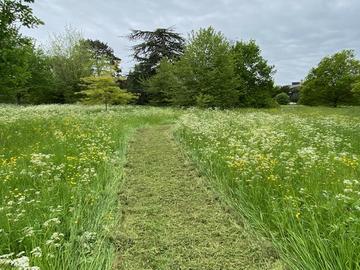There is no doubt that providing food for pollinators is important for their survival. The University Parks supports No Mow May. This is a national campaign which aims to encourage land owners not to mow their lawns in spring so that meadow plants have time to flower. This boosts nectar and pollen to feed insects like bees, bumblebees, butterflies and moths. The seeds of meadow grasses and flowers, together with a thriving insect community, are good for birds. All of this supports biodiversity in urban areas.

There are large areas of the University Parks that are not mown precisely to provide a nectar and pollen source for communities of pollinating insects. Quite apart from the value of these areas in supporting wildlife, they are very beautiful. In the middle of May, I took a walk through the grassland near the Cherwell River with one of the Parks gardeners. He was mowing paths through the meadow, to allow visitors to enjoy the wildflowers. We found a very large variety of wildflowers of many different colours, and decided to increase the area towards the river that we are not going to mow in the spring. If you have ever wondered why we cut the path edges, this has two purposes, one practical and one aesthetic: it prevents vegetation from flopping over the paths, and it makes the site look purposeful rather than abandoned!
On this walk, I noticed how well the hibernaculum is flourishing.
It is not possible to leave all of the grass in the Parks unmown. Not only the sports pitches but the areas around and between them need to be cut to allow for spectators and other informal recreational use. We consider insects in a different way in the more formal areas of the University Parks, planting nectar- and pollen-rich flowering plants...
... or leaving pockets of wilderness.
If, on your walks around the Parks you do find a particularly unusual or rare plant, like a meadow orchid, please let us know what you have seen and where it is located. The easiest way to do this is to tell one of the gardeners, or send a photograph of the plant and its surroundings to university.parks@admin.ox.ac.uk.